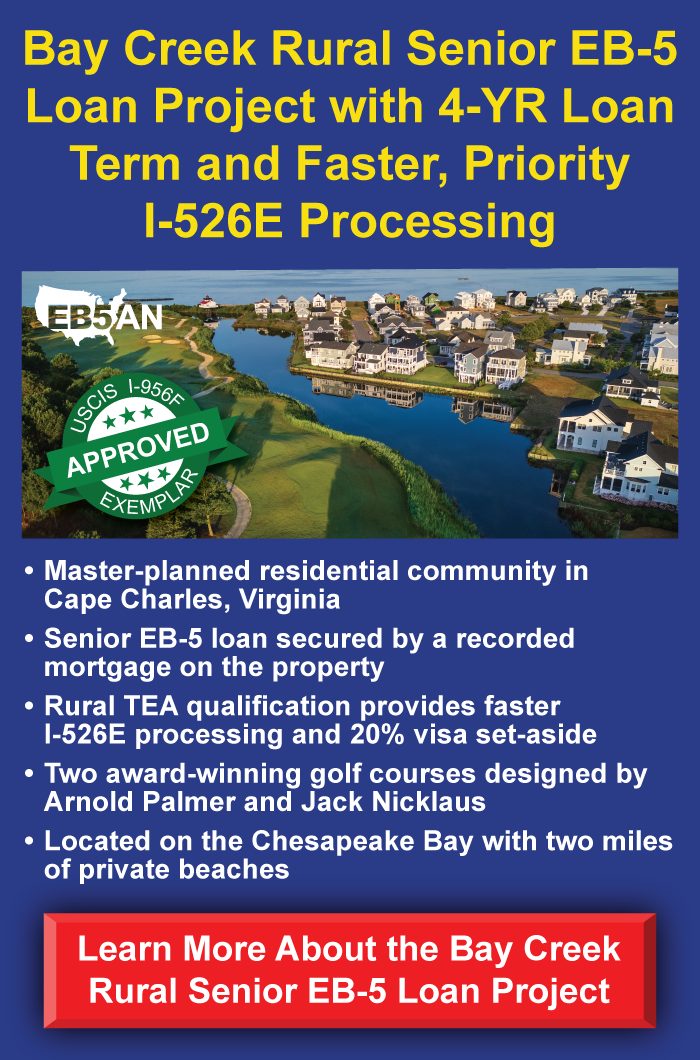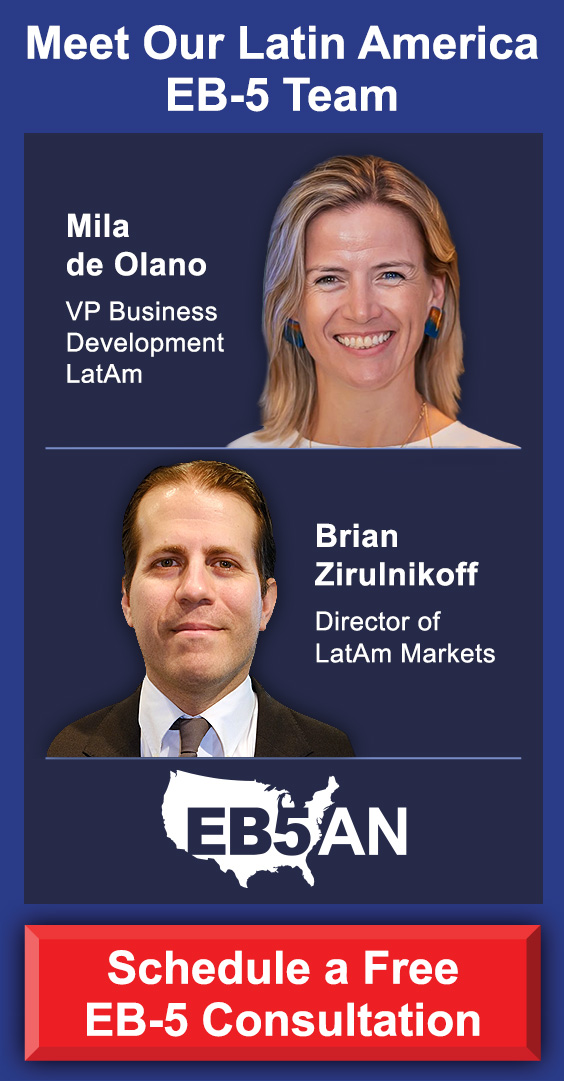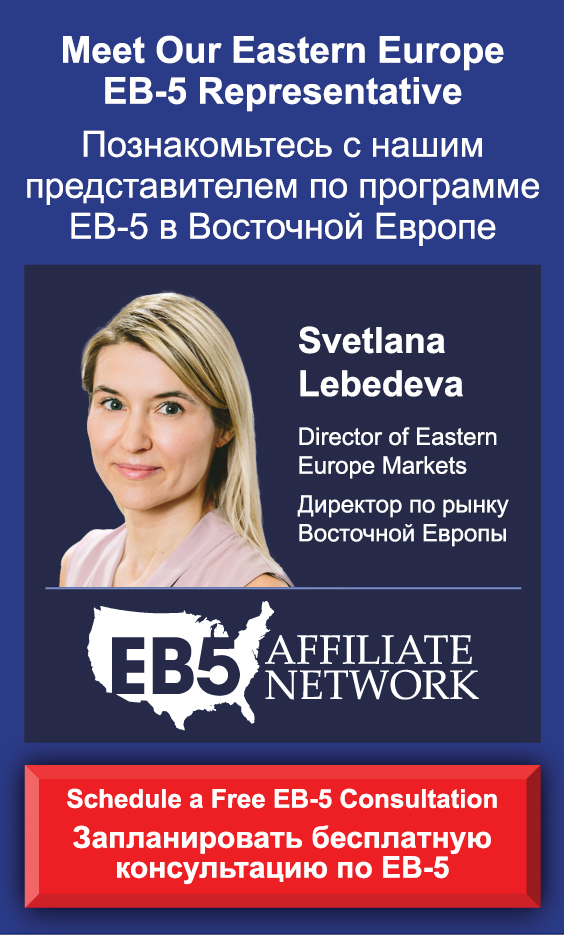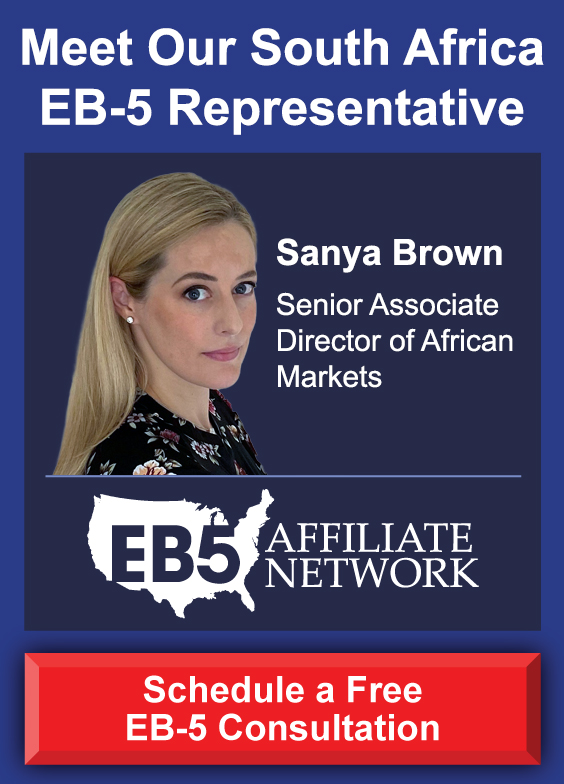The application process under the EB-5 Immigrant Investor Program involves a great deal of legal and financial jargon.
Prospective investors should understand the meanings of these terms so they can make the right decisions.
In this glossary, we’ve identified the most common EB-5 program terms. Study these descriptions, check out the links for additional details, and book a free call with EB5AN to learn more about how you can become a Green Card holder under the EB-5 program.
Key EB-5 Terms Glossary- 10 Full-Time Jobs
- Advance Parole
- Age-Out Risk
- Annual Visa Allotment
- Backlog
- Broker-Dealer
- Capital Investment
- Capital Stack
- Concurrent Filing
- Conditional Resident
- Country Cap
- Dependent Spouse and Children
- Derivative Beneficiaries
- Direct Jobs
- Dual Intent
- Employment Authorization Document (EAD)
- Escrow Account
- Escrow Release Conditions
- Feasibility Study
- Final Action Date
- Form I-485 (Application to Register Permanent Residence or Adjust Status)
- Form I-526 (Immigrant Petition by Alien Investor)
- Form I-526E (Immigrant Petition by Regional Center Investor)
- Form I-829 (Petition by Investor to Remove Conditions on Permanent Resident Status)
- Form I-924 (Application for Regional Center Designation)
- Form I-924A (Annual Certification of Regional Center)
- Form I-956 (Application for Regional Center Designation)
- Form I-956F (Application for Approval of Investment Project)
- Form I-956G (Annual Statement of Compliance)
- Form I-956H (Bona Fides of Persons Involved with Regional Center Program)
- Fund Administrator
- Gift Letter
- Green Card (Permanent Resident Card)
- High-Unemployment Area
- Immigration Attorney
- Indirect Jobs
- Job-Creating Entity (JCE)
- Job Creation Requirement
- Lawful Source of Funds
- Loan Agreement
- Material Change
- NCE (New Commercial Enterprise)
- Principal Applicant
- Priority Date
- Private Placement Memorandum (PPM)
- Processing Time
- Project Developer
- Qualified U.S. Worker
- Re-entry Permit
- Redeployment Policy
- Regional Center Designation
- Risk Disclosure
- Rural Area
- Securities Attorney
- Set-Aside Visas
- Source of Funds
- Subscription Agreement
- Sustainment Period
- Targeted Employment Area (TEA)
- USCIS Adjudication
- Visa Bulletin
Key EB-5 Terms Glossary
10 Full-Time Jobs
An EB-5 investor must create or preserve at least 10 full-time jobs for U.S. workers. These positions must be permanent and each requires at least 35 working hours per week. The jobs must be created within a reasonable time. In direct investment projects, only jobs created by the business’s direct hiring of employees can be counted. However, regional center projects include direct jobs as well as indirect and induced jobs created on the local economy toward the job creation requirement.
Advance Parole
Advance Parole is a travel document that allows foreign nationals to reenter the United States after traveling abroad without invalidating a pending immigration application. EB-5 investors who file Form I-485 (Adjustment of Status) may request Advance Parole to travel while awaiting Green Card approval. It prevents abandonment of their application, but it must be approved before travel.
Age-Out Risk
Refers to a child of an EB-5 investor turning 21 before obtaining permanent residency, which would disqualify them as a dependent. Under the Child Status Protection Act (CSPA), an EB-5 child’s age is calculated as their age at visa availability (based on the Final Action Dates chart) minus the time the I-526/I-526E was pending, which is also known as “freezing” the age. This helps to preserve eligibility.
Annual Visa Allotment
Each fiscal year, the United States allocates a limited number of immigrant visas under the EB-5 program—approximately 10,000 total, including investors and their family members. Visas are divided among categories and countries, which can create wait times for applicants from oversubscribed countries like China and India.
Backlog
A backlog in the EB-5 program refers to the accumulation of unprocessed petitions or visa applications due to demand exceeding annual limits. Backlogs can result in long waiting times, especially for applicants from countries that exceed their annual visa cap, delaying Green Card issuance.
Broker-Dealer
A broker-dealer is a person or firm registered with the SEC and FINRA that is licensed to sell securities, such as EB-5 investment offerings. EB-5 projects raising capital through securities may work with broker-dealers to ensure compliance with U.S. securities laws and proper investor disclosures.
Capital Investment
Under the EB-5 program, capital investment refers to the lawful funds an investor contributes to a new commercial enterprise. The minimum required amount is $1,050,000 for a standard project, or $800,000 if the project is in a Targeted Employment Area (TEA). The investment must be kept “at risk” (not withdrawn) for at least two years and lead to job creation.
Capital Stack
An EB-5 capital stack is the mix of funding sources used to pay for a project, showing how much comes from each type of financing. In an EB-5 deal, this usually includes EB-5 investor funds along with other sources like bank loans, developer equity, or private investments. The “stack” part simply refers to how these funding sources are layered together, with each one having its own role and level of risk. Understanding where EB-5 funds fit in the stack helps investors see how secure their position might be.
Concurrent Filing
Concurrent filing allows EB-5 investors already in the United States on a valid visa to file Form I-526/I-526E and Form I-485 (Adjustment of Status) simultaneously. It streamlines the application process and helps investors obtain permanent resident status faster. This option became available in 2022 under the EB-5 Reform and Integrity Act, enabling investors to stay and work in the United States while their Green Cards are processed.
Conditional Resident
An EB-5 investor who is granted a Green Card initially receives conditional permanent resident status, valid for two years. This status allows the investor and their family to live and work in the United States while they fulfill program requirements. Before the conditional Green Card expires, the investor must file Form I-829 to remove conditions. Failure to do so may result in loss of residency status. Conditional residency ensures that only those who meet the investment and job creation goals receive permanent status.
Country Cap
The United States imposes a per-country cap of about 7% of the annual total EB-5 visa allocation. This cap helps maintain diversity, but can create longer wait times for applicants from high-demand countries. Derivative family members also count toward the cap, impacting overall availability.
Dependent Spouse and Children
An EB-5 investor’s spouse and unmarried children under 21 may apply for Green Cards as derivative beneficiaries. They receive the same immigration benefits as the principal applicant, including permanent residency, and may be included in the investor’s initial petition and adjustment or consular processing.
Derivative Beneficiaries
Derivative beneficiaries are immediate family members (spouse and unmarried children under 21) of the principal EB-5 applicant who are eligible to receive immigrant visas based on the investor’s petition. They are subject to the same priority date and visa availability as the principal applicant.
Direct Jobs
Direct jobs are actual, identifiable positions created by the EB-5 investor’s enterprise. Directly employed workers are on the project’s payroll. These must be W-2, full-time U.S. positions established directly to support the project’s operations. In direct EB-5 investments (not through a regional center), only direct jobs count toward the job creation requirement.
Dual Intent
Dual intent refers to the ability of foreign nationals to apply for a U.S. visa while also intending to seek permanent residency. EB-5 investors can hold dual intent, meaning they may enter on a temporary visa (like H-1B) without jeopardizing future Green Card plans.
Employment Authorization Document (EAD)
An EAD (also known as Form I-765) is an open work permit that allows individuals to legally work in the United States while waiting for their Green Card. EB-5 investors who file Form I-485 can also apply for an EAD. This provides work authorization during the adjustment period. EB-5 EADs are typically approved within six months and are valid for five years.
Escrow Account
An escrow account is a secure financial arrangement in which an EB-5 investor’s funds are held by a neutral third party until certain conditions—such as petition approval—are met. Escrow helps to make transactions more secure, and ensures funds are not misused before United States Citizenship and Immigration Services (USCIS) adjudicates the investor’s application.
Escrow Release Conditions
These are predefined terms under which EB-5 investment funds are released from escrow. Common escrow release conditions include I-526/I-526E petition approval or project milestones being met. Properly structured escrow conditions protect the investor and ensure regulatory compliance during fund disbursement.
Feasibility Study
A feasibility study evaluates the economic, financial, and operational viability of an EB-5 project. It typically includes market research, job creation projections, and risk assessments. A credible feasibility study helps investors and USCIS assess whether the business plan will meet EB-5 job creation and investment criteria.
Final Action Date
The Final Action Date, published monthly in the Visa Bulletin, indicates when Green Cards can be issued for a particular EB-5 applicant based on their priority date and country. If an applicant’s priority date is earlier than the Final Action Date, their visa is ready to be issued.
Form I-485 (Application to Register Permanent Residence or Adjust Status)
Form I-485 is used by EB-5 investors (and other eligible applicants) already in the United States to apply for a Green Card without leaving the country. Filing this form initiates the process of adjusting from a nonimmigrant to immigrant status. For EB-5 investors, concurrent filing with Form I-526E became available under the EB-5 Reform and Integrity Act of 2022. When filed, applicants may also request an Employment Authorization Document and Advance Parole. Approval of I-485 grants conditional permanent resident status, pending the removal of conditions via Form I-829.
Form I-526 (Immigrant Petition by Alien Investor)
Form I-526 is the petition filed by an EB-5 direct investor to demonstrate eligibility for the EB-5 visa. The form proves that the investor has invested, or is actively in the process of investing, the required amount of capital into a new commercial enterprise (NCE) and that the investment will create at least 10 full-time U.S. jobs. This form applies to standalone (non-regional center) projects. Approval of I-526 establishes the investor’s eligibility and priority date.
Form I-526E (Immigrant Petition by Regional Center Investor)
Form I-526E, introduced by the EB-5 Reform and Integrity Act of 2022, is used by EB-5 investors participating in regional center projects. It is similar to Form I-526, but specifically applies to pooled investments through approved regional centers. Investors must demonstrate that their capital is lawfully sourced, invested into a qualifying project, and expected to generate the required job creation. The regional center must have already submitted a project request (Form I-956F). Approval of I-526E establishes the investor’s eligibility and priority date.
Form I-829 (Petition by Investor to Remove Conditions on Permanent Resident Status)
Form I-829 is filed by EB-5 investors to remove the two-year conditional status on their Green Cards. This petition must be submitted within the 90-day window before the conditional Green Card expires. The investor must prove that the required investment was sustained throughout the period and that the business created (or will create) at least 10 full-time U.S. jobs. Approval of the I-829 petition grants the investor and qualifying family members full, unrestricted permanent residency (a 10-year Green Card).
Form I-924 (Application for Regional Center Designation)
Form I-924 was historically used by individuals or entities seeking to obtain designation as a USCIS-approved EB-5 regional center. Regional centers are organizations authorized to sponsor capital investment projects for EB-5 investors. The form required submission of detailed business plans, economic models, and job creation forecasts. Since the EB-5 Reform and Integrity Act took effect, this form has been replaced by newer forms (e.g., I-956 series) that implement additional compliance and transparency requirements.
Form I-924A (Annual Certification of Regional Center)
Form I-924A was filed annually by approved regional centers to demonstrate continued eligibility and compliance with EB-5 regulations. It included updates on affiliated projects, capital raised, job creation statistics, and other required metrics. Regional centers failing to submit I-924A risked termination of designation. After passage of the EB-5 Reform and Integrity Act of 2022, USCIS replaced this form with a more comprehensive framework under the I-956 series, requiring greater transparency and disclosures from regional centers.
Form I-956 (Application for Regional Center Designation)
Form I-956 is the current application submitted by entities seeking USCIS designation as EB-5 regional centers under the EB-5 Reform and Integrity Act of 2022. It replaced the former Form I-924. The form requires detailed organizational and compliance documentation, including fund management practices, business plans, investment structures, and job creation forecasts. Approval enables the regional center to sponsor projects and submit exemplar filings for investor use.
Form I-956F (Application for Approval of Investment Project)
Form I-956F is submitted by designated regional centers to request USCIS approval of a specific EB-5 investment project. This form must be filed and received before investors in the project can submit their Form I-526E petitions. The form includes comprehensive documentation such as offering materials, economic impact analysis, job creation projections, and securities compliance statements. Approval of I-956F does not guarantee investor petition approval but serves as a prerequisite.
Form I-956G (Annual Statement of Compliance)
Form I-956G is the annual reporting requirement for all approved EB-5 regional centers. It must be filed each fiscal year to confirm ongoing compliance with USCIS regulations. The report includes information about sponsored projects, investor data, fund usage, job creation, and adherence to securities laws. Regional centers must also disclose third-party relationships and fund administrators. Failure to file may result in termination of the regional center designation.
Form I-956H (Bona Fides of Persons Involved with Regional Center Program)
Form I-956H must be submitted by each individual involved in the ownership, management, or promotion of an EB-5 regional center or project. It is a background check form that ensures all key personnel are of good moral character and free from conflicts of interest, fraud, or criminal activity. The form helps USCIS maintain the integrity of the program by vetting those in positions of authority over EB-5 investments.
Fund Administrator
A fund administrator is a third-party financial professional or firm hired to oversee the handling, disbursement, and reporting of EB-5 investment funds. Their role includes verifying that funds are used according to offering documents, maintaining transparency, and protecting investor interests. Under the EB-5 Reform and Integrity Act of 2022, the use of an independent fund administrator (or audited financials) is required to ensure compliance and prevent misuse of capital. A fund administrator must be a registered investment adviser, an immigration attorney, CPA, or a broker-dealer.
Gift Letter
A gift letter is a legal document used to certify that a portion of an EB-5 investor’s capital was received as a gift rather than a loan or income. USCIS requires clear documentation proving the lawful source of all investment funds, including gifts. The letter typically includes the donor’s relationship to the investor, the amount gifted, confirmation that the gift is not a loan, and evidence that the donor obtained the funds legally. Gifted funds must still meet EB-5 source-of-funds scrutiny.
Green Card (Permanent Resident Card)
A Green Card grants lawful permanent resident (LPR) status in the United States, allowing a foreign national to live and work permanently in the country. Approved EB-5 investors and qualifying family members first receive a conditional Green Card valid for two years. If the investment meets all program requirements—including job creation—the investor can file Form I-829 to remove conditions. Upon approval, the investor receives a permanent Green Card (valid for 10 years and renewable), which can later lead to U.S. citizenship.
High-Unemployment Area
A High-Unemployment Area (HUA) is a subcategory of Targeted Employment Area (TEA) where the unemployment rate is at least 150% of the national average. Investments in HUAs qualify for the reduced EB-5 minimum investment threshold ($800,000 instead of $1,050,000). Under the EB-5 Reform and Integrity Act of 2022, TEA designations, including HUAs, are now made exclusively by USCIS using census tract data, eliminating previous state authority over TEA determinations.
Immigration Attorney
An immigration attorney provides legal counsel to EB-5 investors throughout the visa process. Services include advising on lawful source-of-funds documentation, preparing and filing petitions (Forms I-526/I-526E, I-485, I-829), monitoring compliance, and responding to USCIS requests or denials. Attorneys also assist in structuring the investment to meet EB-5 requirements. Due to the complexity of EB-5 law and evolving regulations, retaining a knowledgeable EB-5 attorney is strongly recommended to improve petition accuracy and reduce processing delays.
Indirect Jobs
Indirect jobs are employment positions created as a result of EB-5 investment activity but not directly employed by the new commercial enterprise. These include jobs generated through economic ripple effects—such as suppliers or service providers. Indirect job creation is calculated using economic models (like RIMS II or IMPLAN) and is only countable in regional center-sponsored projects. Direct EB-5 investments cannot count indirect jobs toward the 10-job requirement.
Job-Creating Entity (JCE)
The JCE is the business or project that receives EB-5 investor capital and is responsible for creating the required jobs. In a regional center model, investors place funds into a new commercial enterprise (NCE), which then loans or invests the capital into the JCE. The JCE is typically responsible for project execution, operations, and hiring. Accurate tracking and documentation of job creation by the JCE are essential for I-829 approval.
Job Creation Requirement
The EB-5 program mandates that each investor’s capital must lead to the creation of at least 10 full-time jobs for qualified U.S. workers. These jobs must be permanent and require at least 35 hours per week. Direct investments may count only direct jobs, while regional center investments may count direct, indirect, and induced jobs. USCIS evaluates job creation through business plans, economic modeling, and documentation submitted during the I-526/I-526E and I-829 petition processes.
Lawful Source of Funds
EB-5 investors must prove that their investment capital comes from legal sources. This requirement ensures the funds were not obtained through illegal means such as money laundering or fraud. Documentation typically includes tax returns, bank statements, employment records, business income, sale of property, or inheritance documents. If funds are gifted or loaned, additional evidence (e.g., gift letters or loan agreements) is needed. USCIS applies rigorous scrutiny to source-of-funds evidence to prevent abuse of the immigration system.
Loan Agreement
In EB-5, a loan agreement outlines the terms under which funds were borrowed to make the qualifying investment. If an investor uses borrowed funds, the loan must be secured by their personal assets—not by the assets of the EB-5 enterprise. The agreement must clearly state repayment terms, interest rates, and collateral. USCIS requires proof that the loan is lawful, enforceable, and places the investor at financial risk, consistent with the “at risk” requirement of EB-5. USCIS also accepts unsecured loans as a valid source of funds, provided the loan is properly documented and the capital can be traced back to a lawful origin.
Material Change
A material change is a significant alteration in an EB-5 project or the investor’s circumstances that could impact USCIS’s adjudication of the petition. Examples include changes in business structure, job creation methodology, investment amount, or the project’s location. USCIS may deny petitions if a material change occurs after filing but before adjudication. Under current guidance, once an I-526E is approved, certain changes may be permissible, especially if they don’t affect the investor’s eligibility or job creation projections. Regional centers must also report material changes to maintain compliance.
NCE (New Commercial Enterprise)
A new commercial enterprise (NCE) is the entity into which EB-5 capital is invested. It must be a for-profit entity established after November 29, 1990 or a preexisting business that has been significantly restructured. The NCE can take various legal forms (LLC, corporation, partnership) and may directly or indirectly create the required jobs. In regional center models, the NCE often acts as a fund that loans or invests the capital into a job-creating entity (JCE). The NCE is central to USCIS’s review of job creation, fund deployment, and business activity.
Principal Applicant
The principal applicant is the primary individual applying for the EB-5 immigrant visa—typically the person making the qualifying investment. This applicant’s eligibility, source of funds, and investment structure determine the outcome of the case. The principal’s spouse and unmarried children under 21 are considered derivative beneficiaries. Only the principal applicant is required to meet the investment and job creation thresholds, but all eligible family members may benefit from the approval of the petition and receive Green Cards.
Priority Date
A priority date is the date when USCIS officially receives an EB-5 investor’s Form I-526 or I-526E petition. It’s also called a filing date or receipt date. This date determines the investor’s place in line for visa availability. If visa demand exceeds the annual or country-specific quota, applicants must wait for their priority date to become current in the Visa Bulletin’s Final Action Date chart. The priority date is critical for tracking wait times, especially for applicants from high-demand countries like China or India.
Private Placement Memorandum (PPM)
A Private Placement Memorandum (PPM) is a legal disclosure document provided to prospective EB-5 investors. It outlines the terms, risks, and structure of the investment offering, including the use of funds, potential returns, and exit strategies. The PPM must comply with U.S. securities laws. It is critical in helping investors evaluate whether the opportunity aligns with their financial goals and immigration plans. It also protects issuers by providing clear disclosure of all material facts.
Processing Time
Processing time refers to the length of time that USCIS takes to adjudicate a specific EB-5 form (e.g., I-526E, I-829). These times vary by petition type, investor location, and case complexity. USCIS posts estimated time ranges on its website, but actual times can be longer, especially for petitions from countries facing backlogs. Delays may also occur due to Requests for Evidence (RFEs), policy changes, or staffing shortages. Processing time significantly affects investor planning and project timelines.
Project Developer
A project developer is the entity or individual responsible for planning, building, and operating the EB-5 investment project. Developers work with regional centers, attorneys, economists, and marketing teams to structure the project, raise capital, and fulfill USCIS requirements. Their role is crucial in ensuring that EB-5 funds are properly deployed and that job creation goals are met. Experienced developers with a strong track record can provide greater confidence for investors assessing project viability.
Qualified U.S. Worker
For EB-5 purposes, a qualified U.S. worker is a U.S. citizen, lawful permanent resident, asylee, or refugee authorized to work in the United States. The jobs created through the EB-5 investment must employ these workers on a full-time basis (at least 35 hours per week). Family members of the EB-5 investor cannot be counted as qualified U.S. workers for the job creation requirement. This definition ensures that the EB-5 program contributes directly to the domestic labor market.
Re-entry Permit
A reentry permit is a travel document that allows a conditional or permanent Green Card holder to return to the United States after extended travel abroad—generally more than six months and up to two years—without risking abandonment of permanent resident status. It is valid for up to two years and is obtained by filing Form I-131. EB-5 investors awaiting I-829 approval or managing business overseas often apply for a reentry permit to protect their residency status during prolonged absences.
Redeployment Policy
Redeployment policy refers to the reinvestment of EB-5 capital after the original project has repaid the funds but before the two-year sustainment period has ended. USCIS requires the investment to remain “at risk” throughout the sustainment period. Redeployment must be in a commercial activity within the United States and follow the investor’s original business intent. The policy ensures continued compliance while offering flexibility to adapt to business developments. Documentation of redeployment is critical for I-829 approval.
Regional Center Designation
A regional center is an entity that USCIS has designated to sponsor EB-5 investment projects and pool capital from multiple investors. Designation is granted based on evidence that the regional center will promote economic growth, job creation, and increased capital investment in a specific geographic area. Regional centers allow for more flexible job creation calculations, including indirect and induced jobs. Because of the EB-5 Reform and Integrity Act of 2022, regional centers must now meet more rigorous compliance, auditing, and reporting requirements using new Form I-956 series applications.
Risk Disclosure
Risk disclosures are formal statements included in EB-5 offering documents (like the PPM) that outline potential financial, immigration, and regulatory risks associated with an investment. These may include market fluctuations, project failure, immigration petition denial, or changes in law. Full and honest disclosure is legally required under U.S. securities laws and provides transparency for investors. Proper risk disclosure protects both the issuer and investor and is essential to a valid and compliant EB-5 offering.
Rural Area
A rural area, for EB-5 purposes, is a location not within a metropolitan statistical area (MSA) and not within a city or town with a population of 20,000 or more. EB-5 investments in rural areas qualify for reduced investment thresholds ($800,000) and receive visa set-asides and priority processing under the EB-5 Reform and Integrity Act. These areas are targeted to encourage job creation in economically underserved communities and are determined based on U.S. Census and OMB data.
Securities Attorney
A securities attorney advises on compliance with U.S. securities laws in connection with EB-5 offerings. They draft or review offering documents (like PPMs and subscription agreements), structure investment vehicles, and ensure disclosure and anti-fraud compliance under SEC and FINRA regulations. Their role is critical in minimizing legal risks for regional centers, developers, and investors. Given the complexity of EB-5 investment structures, retaining a qualified securities attorney is essential for lawful capital raising.
Set-Aside Visas
Set-aside visas are EB-5 Green Cards specifically reserved for investors in certain categories of projects. The total number of EB-5 visas is allocated to project categories each year as follows: 20% for rural areas, 10% for high-unemployment areas, and 2% for infrastructure projects. These categories help investors from high-demand countries avoid long wait times. The EB-5 Reform and Integrity Act of 2022 introduced set-aside visas to promote geographic diversity and distribute economic benefits more equitably.
Source of Funds
Source of funds refers to the documentation and verification of where an EB-5 investor obtained the capital used for their investment. USCIS requires extensive evidence that the funds were obtained legally. Such evidence can include financial records, tax documents, property sale agreements, inheritance papers, and employment income records. If the funds are loaned or gifted, additional documentation such as loan agreements or gift letters must be included. Clear and well-documented source of funds packages are critical to EB-5 petition approval.
Subscription Agreement
A subscription agreement is a binding contract between the EB-5 investor and the new commercial enterprise. It confirms the investor’s intent to invest in the project under specified terms and lays out the rights, obligations, and conditions of the investment. The agreement typically accompanies the PPM and includes representations about the investor’s qualifications and understanding of the risks. USCIS expects to see executed subscription agreements as part of I-526E filings.
Sustainment Period
The sustainment period is the time during which EB-5 investors must maintain their investment in the NCE to qualify for removal of conditions. For petitions filed after the 2022 Reform and Integrity Act, this period is two years, beginning when funds are invested and made available to the JCE. During this time, the investment must remain “at risk” and actively deployed in a job-creating enterprise. USCIS may deny Form I-829 if the investment is withdrawn or becomes inactive before the sustainment period ends.
Targeted Employment Area (TEA)
A targeted employment area is a designated location that qualifies for a reduced minimum EB-5 investment of $800,000. TEAs include rural areas and high-unemployment areas (150% of the national average). Under the EB-5 Reform and Integrity Act, USCIS now directly determines TEA designations based on census data. This change ensures uniformity and prevents inconsistent or manipulated designations. Investing in a TEA offers both a lower threshold and potential visa set-aside benefits.
USCIS Adjudication
USCIS adjudication refers to the official review and decision-making process on EB-5 forms like I-526E, I-485, and I-829. Officers assess eligibility based on investment amount, job creation, source of funds, and project compliance. Adjudication may result in approval, denial, or a request for evidence. Processing times vary, and adjudication may be delayed by case complexity or volume. The EB-5 Reform and Integrity Act introduced more oversight and reporting obligations to support accurate and timely adjudication.
Visa Bulletin
Published monthly by the U.S. Department of State, the Visa Bulletin provides updates on the availability of immigrant visas, including EB-5 Green Cards. It lists Final Action Dates and Dates for Filing for each visa category and country. Applicants must monitor the bulletin to determine when their priority date is current, allowing them to proceed with visa issuance or adjustment of status. Backlogs for countries with high demand (e.g., China, India) are reflected in the Visa Bulletin’s cutoff dates.
If you have questions about any of the terms above or want to learn more about the EB-5 Green Card program, our expert team is here to help. Schedule a free consultation today.












